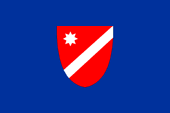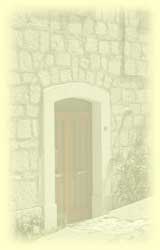|
|
|

Molise — Regione Molise
 The country of Italy (Italia) is subdivided into 20 regions (regioni, singular regione). Each region is sub-divided into provinces, which are then further sub-divided into any number of municipalities (cities or towns, called comuni or singular comune). This is similar to the United States which has 50 states, each with counties or parishes, and cities or towns within each county or parish.
The country of Italy (Italia) is subdivided into 20 regions (regioni, singular regione). Each region is sub-divided into provinces, which are then further sub-divided into any number of municipalities (cities or towns, called comuni or singular comune). This is similar to the United States which has 50 states, each with counties or parishes, and cities or towns within each county or parish.
Within an individual American city or town, there are often additional names given to neighborhoods or sections of town — in Italy, they would be called frazione (or fraction).
The regions of Italy and their respective capitals are:
Abruzzo (L'Aquila), Basilicata (Potenza), Calabria (Catanzaro), Campania (Naples, Napoli), Emilia-Romagna (Bologna), Friuli-Venezia Giulia (Trieste), Latium / Lazio (Rome, Roma), Liguria (Genoa, Genova), Lombardy / Lombardia (Milan, Milano), Marches / Marche (Ancona), Molise (Campobasso), Piedmont / Piemonte (Turin, Torino), Apulia / Puglia (Bari), Sardinia / Sardegna (Cagliari), Aosta Valley / Valle d'Aosta (Aosta), Tuscany / Toscana (Florence, Firenze), Trentino-South Tyrol / Trentino-Alto Adige (Trento), Umbria (Perugia), Sicily / Sicilia (Palermo), and Veneto (Venice, Venezia).
The region of Molise (Regione Molise) is divided into just two Provinces — Isernia and Campobasso. Campobasso is also the name of the capital city of Molise. Molise is a region of South Central Italy, the second smallest of the regions. It was formerly (until 1963) part of the region of Abruzzi e Molise (with Abruzzo) and now a separate entity. The region covers 4,438 km˛ and has a population of about 300,000.

History of Molise
After the fall of the Roman Empire in 476 AD Molise was invaded by the Goths (535 AD) and then by the Languebards (or Lombards) in 572, and annexed to the Dukedom of Benevento. A very troubled period began with the invasions of the Saracens, that in 860 AD destroyed Isernia, Telese, Alife, Sepino, Boiano and Venafro. By the 10th century there were 9 countdoms: Venafro, Larino, Trivento, Bojano, Isernia, Campomarino, Termoli, Sangro, Pietrabbondante. In 1095 the most powerful of them, Bojano, came under the rule of the Norman Hugo I of Molhouse, who most probably gave his name to the region; his successor Ugo II was Count of Molise in 1144. In the 16th century Molise was included to the Province of Capitanata (Apulia) and in 1806 became an autonomous Province, included in the Abruzzi region. In the 19th century there was a general worsening of the economic conditions of the population, and this gave rise, under the newly established Kingdom of Italy (1861), to brigandage and a massive emigration not only abroad but also to more industrial Italian areas. A heavy destruction took place in WW2, until finally the Allied Forces were able to land at Termoli, in September 1943. Huge Allied land forces were based in Campobasso which was called "Maple Leaf City" by the Canadian troops. Molise is the youngest Italian region, since it was established in 1963, when the region "Abruzzi e Molise" was split into two regions, which, however, still today maintain a common identity both geographically and in their historical and traditional heritage.
Economy of Molise
Agriculture is still of considerable importance, though it is an impoverished sector, frequently subsistence farming, and characterized by large numbers of tiny holdings. The most common crops are wheat, broad beans and potatoes. Olives and wine-growing are of a certain importance, as are some vegetables and sunflowers. Livestock is decreasing except for the traditional sheep-farming, while fishing is of little importance, since the only available port is Termoli. Mineral resources consist of the natural gas deposits at Larino. The industrial sector is underdeveloped and there is only one real industrialized area, near Termoli, with engineering, textile, foodstuff, furniture and building materials factories. Elsewhere, firms are small and semi-artisan, operating principally in the textile, woodworking, food processing and building materials sectors. The service sector employs just under half the active population; here the commercial sector, though badly organized and the public sector, which has been expanded since the Region and the Province of Isernia were established (1970), are of particular importance.
Demographics of Molise
On the whole, Molise is the least populated Italian region after the Val d'Aosta, with also a very low average density of population. Apart from the historical difficulties of settling in a territory which is mainly mountainous, this is due to a flow of emigrants abroad and to other Italian regions, a phenomenon which reached a peak at the beginning of the century and in the post-war period, and started to decline to a certain extent only from the 1970s onwards. The population distribution is highest in the areas surrounding Campobasso, the regional capital, and along the Adriatic coast, while the mountainous areas (for example in the Province of Isernia) are almost uninhabited. In the region there are two ethnic minorities: the Molisan Croatians (2,500 people who speak an old dialect of the Croatian-Dalmatian language) and the Molisan Albanians (who speak an old dialect of the Albanian language which is now very different from the Albanian spoken on the other side of the Adriatic Sea). Molisan Albanians are generally of the Orthodox religion.
Comuni di Campobasso
 Comuni of the Province of Isernia include:
Acquaviva d'Isernia, Agnone, Bagnoli del Trigno, Belmonte del Sannio, Cantalupo nel Sannio, Capracotta, Carovilli, Carpinone, Castel San Vincenzo, Castel del Giudice, Castelpetroso, Castelpizzuto, Castelverrino, Cerro al Volturno, Chiauci, Civitanova del Sannio, Colli a Volturno, Conca Casale, Filignano, Forlė del Sannio, Fornelli, Frosolone, Isernia, Longano, Macchia d'Isernia, Macchiagodena, Miranda, Montaquila, Montenero Val Cocchiara, Monteroduni, Pesche, Pescolanciano, Pescopennataro, Pettoranello del Molise, Pietrabbondante, Pizzone, Poggio Sannita, Pozzilli, Rionero Sannitico, Roccamandolfi, Roccasicura, Rocchetta a Volturno, San Pietro Avellana, Sant'Agapito, Sant'Angelo del Pesco, Sant'Elena Sannita, Santa Maria del Molise, Scapoli, Sessano del Molise, Sesto Campano, Vastogirardi, Venafro
Comuni of the Province of Isernia include:
Acquaviva d'Isernia, Agnone, Bagnoli del Trigno, Belmonte del Sannio, Cantalupo nel Sannio, Capracotta, Carovilli, Carpinone, Castel San Vincenzo, Castel del Giudice, Castelpetroso, Castelpizzuto, Castelverrino, Cerro al Volturno, Chiauci, Civitanova del Sannio, Colli a Volturno, Conca Casale, Filignano, Forlė del Sannio, Fornelli, Frosolone, Isernia, Longano, Macchia d'Isernia, Macchiagodena, Miranda, Montaquila, Montenero Val Cocchiara, Monteroduni, Pesche, Pescolanciano, Pescopennataro, Pettoranello del Molise, Pietrabbondante, Pizzone, Poggio Sannita, Pozzilli, Rionero Sannitico, Roccamandolfi, Roccasicura, Rocchetta a Volturno, San Pietro Avellana, Sant'Agapito, Sant'Angelo del Pesco, Sant'Elena Sannita, Santa Maria del Molise, Scapoli, Sessano del Molise, Sesto Campano, Vastogirardi, Venafro
 Comuni of the Province of Campobasso include:
Acquaviva Collecroce, Baranello, Bojano, Bonefro, Busso, Campobasso, Campochiaro, Campodipietra, Campolieto, Campomarino, Casacalenda, Casalciprano, Castelbottaccio, Castellino del Biferno, Castelmauro, Castropignano, Cercemaggiore, Cercepiccola, Civitacampomarano, Colle d'Anchise, Colletorto, Duronia, Ferrazzano, Fossalto, Gambatesa, Gildone, Guardialfiera, Guardiaregia, Guglionesi, Jelsi, Larino, Limosano, Lucito, Lupara, Macchia Valfortore, Mafalda, Matrice, Mirabello Sannitico, Molise, Monacilioni, Montagano, Montecilfone, Montefalcone nel Sannio, Montelongo, Montemitro, Montenero di Bisaccia, Montorio nei Frentani, Morrone del Sannio, Oratino, Palata, Petacciato, Petrella Tifernina, Pietracatella, Pietracupa, Portocannone, Provvidenti, Riccia, Ripabottoni, Ripalimosani, Roccavivara, Rotello, Salcito, San Biase, San Felice del Molise, San Giacomo degli Schiavoni, San Giovanni in Galdo, San Giuliano del Sannio, San Giuliano di Puglia, San Martino in Pensilis, San Massimo, San Polo Matese, Sant'Angelo Limosano, Sant'Elia a Pianisi, Santa Croce di Magliano, Sepino, Spinete, Tavenna, Termoli, Torella del Sannio, Toro, Trivento, Tufara, Ururi, Vinchiaturo
Comuni of the Province of Campobasso include:
Acquaviva Collecroce, Baranello, Bojano, Bonefro, Busso, Campobasso, Campochiaro, Campodipietra, Campolieto, Campomarino, Casacalenda, Casalciprano, Castelbottaccio, Castellino del Biferno, Castelmauro, Castropignano, Cercemaggiore, Cercepiccola, Civitacampomarano, Colle d'Anchise, Colletorto, Duronia, Ferrazzano, Fossalto, Gambatesa, Gildone, Guardialfiera, Guardiaregia, Guglionesi, Jelsi, Larino, Limosano, Lucito, Lupara, Macchia Valfortore, Mafalda, Matrice, Mirabello Sannitico, Molise, Monacilioni, Montagano, Montecilfone, Montefalcone nel Sannio, Montelongo, Montemitro, Montenero di Bisaccia, Montorio nei Frentani, Morrone del Sannio, Oratino, Palata, Petacciato, Petrella Tifernina, Pietracatella, Pietracupa, Portocannone, Provvidenti, Riccia, Ripabottoni, Ripalimosani, Roccavivara, Rotello, Salcito, San Biase, San Felice del Molise, San Giacomo degli Schiavoni, San Giovanni in Galdo, San Giuliano del Sannio, San Giuliano di Puglia, San Martino in Pensilis, San Massimo, San Polo Matese, Sant'Angelo Limosano, Sant'Elia a Pianisi, Santa Croce di Magliano, Sepino, Spinete, Tavenna, Termoli, Torella del Sannio, Toro, Trivento, Tufara, Ururi, Vinchiaturo
Source: Much of the above text is courtesy of Wikipedia.com
|
|





 The country of Italy (Italia) is subdivided into 20 regions (regioni, singular regione). Each region is sub-divided into provinces, which are then further sub-divided into any number of municipalities (cities or towns, called comuni or singular comune). This is similar to the United States which has 50 states, each with counties or parishes, and cities or towns within each county or parish.
The country of Italy (Italia) is subdivided into 20 regions (regioni, singular regione). Each region is sub-divided into provinces, which are then further sub-divided into any number of municipalities (cities or towns, called comuni or singular comune). This is similar to the United States which has 50 states, each with counties or parishes, and cities or towns within each county or parish.

 Comuni of the Province of Isernia include:
Acquaviva d'Isernia, Agnone, Bagnoli del Trigno, Belmonte del Sannio, Cantalupo nel Sannio, Capracotta, Carovilli, Carpinone, Castel San Vincenzo, Castel del Giudice, Castelpetroso, Castelpizzuto, Castelverrino, Cerro al Volturno, Chiauci, Civitanova del Sannio, Colli a Volturno, Conca Casale, Filignano, Forlė del Sannio, Fornelli, Frosolone, Isernia, Longano, Macchia d'Isernia, Macchiagodena, Miranda, Montaquila, Montenero Val Cocchiara, Monteroduni, Pesche, Pescolanciano, Pescopennataro, Pettoranello del Molise, Pietrabbondante, Pizzone, Poggio Sannita, Pozzilli, Rionero Sannitico, Roccamandolfi, Roccasicura, Rocchetta a Volturno, San Pietro Avellana, Sant'Agapito, Sant'Angelo del Pesco, Sant'Elena Sannita, Santa Maria del Molise, Scapoli, Sessano del Molise, Sesto Campano, Vastogirardi, Venafro
Comuni of the Province of Isernia include:
Acquaviva d'Isernia, Agnone, Bagnoli del Trigno, Belmonte del Sannio, Cantalupo nel Sannio, Capracotta, Carovilli, Carpinone, Castel San Vincenzo, Castel del Giudice, Castelpetroso, Castelpizzuto, Castelverrino, Cerro al Volturno, Chiauci, Civitanova del Sannio, Colli a Volturno, Conca Casale, Filignano, Forlė del Sannio, Fornelli, Frosolone, Isernia, Longano, Macchia d'Isernia, Macchiagodena, Miranda, Montaquila, Montenero Val Cocchiara, Monteroduni, Pesche, Pescolanciano, Pescopennataro, Pettoranello del Molise, Pietrabbondante, Pizzone, Poggio Sannita, Pozzilli, Rionero Sannitico, Roccamandolfi, Roccasicura, Rocchetta a Volturno, San Pietro Avellana, Sant'Agapito, Sant'Angelo del Pesco, Sant'Elena Sannita, Santa Maria del Molise, Scapoli, Sessano del Molise, Sesto Campano, Vastogirardi, Venafro
 Comuni of the Province of Campobasso include:
Acquaviva Collecroce, Baranello, Bojano, Bonefro, Busso,
Comuni of the Province of Campobasso include:
Acquaviva Collecroce, Baranello, Bojano, Bonefro, Busso,